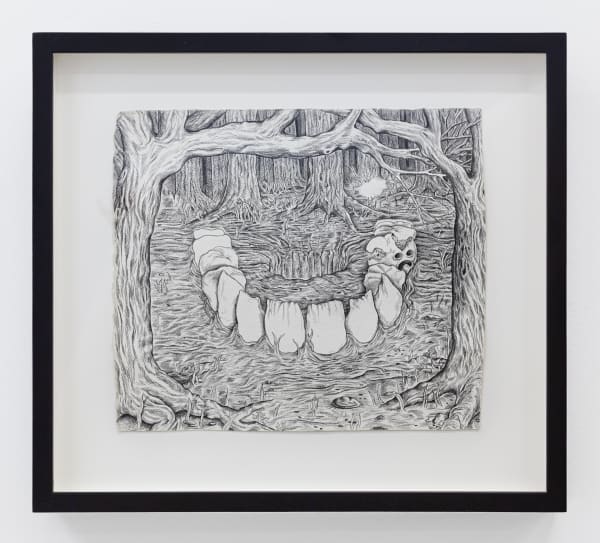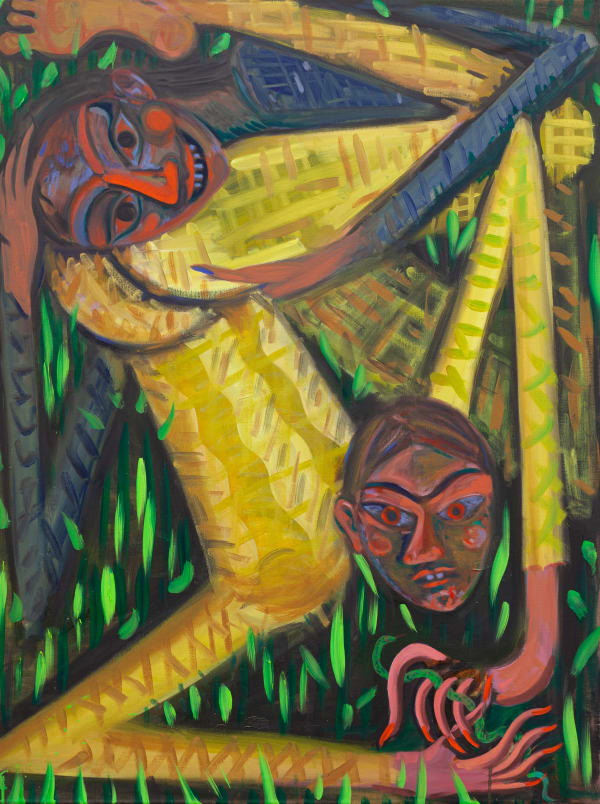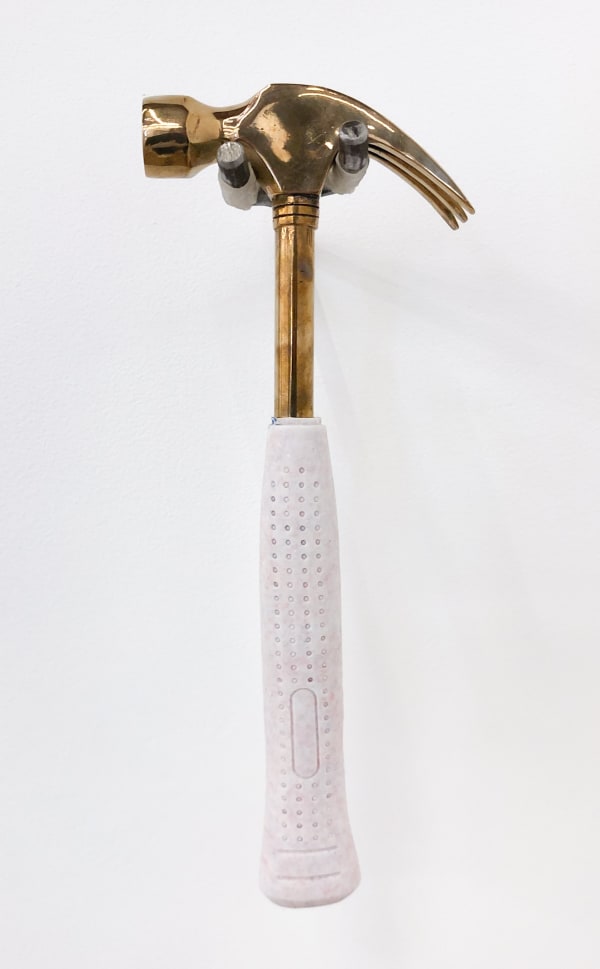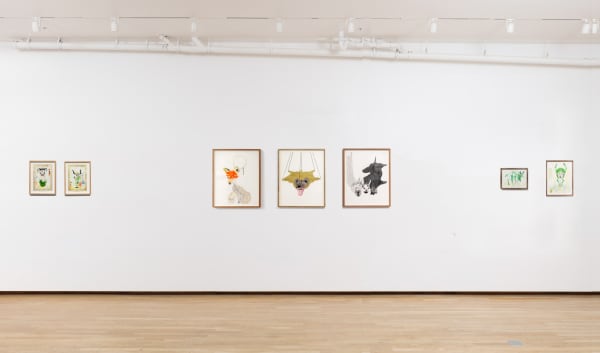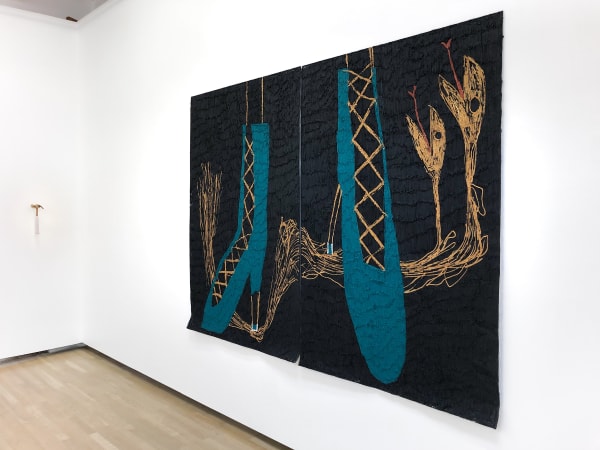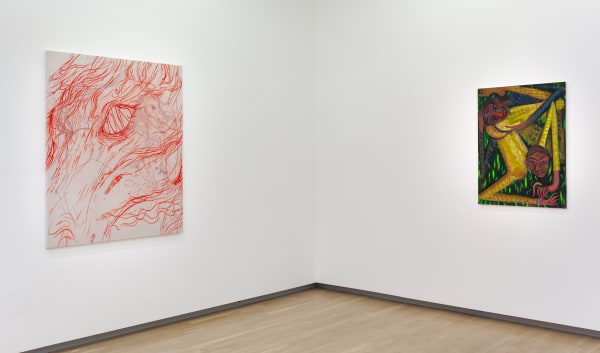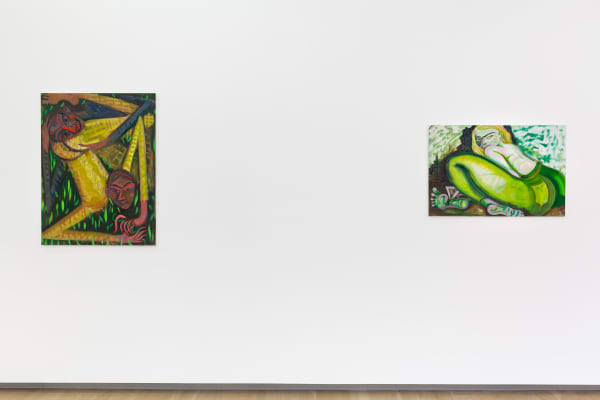Turn back, Turn Back!
Diana Yesenia Alvarado, Trenton Doyle Hancock, Rainen Knecht, Lila de Magalhaes, Elham Rokni, Summer Wheat and Tori Wrånes
Shulamit Nazarian is pleased to present Turn Back, Turn Back! an exhibition of works by Diana Yesenia Alvarado, Trenton Doyle Hancock, Rainen Knecht, Lila de Magalhaes, Elham Rokni, Summer Wheat and Tori Wrånes. These artists explore narrative structures that resonate with a deep history of storytelling found in ancient myths, fables, and folktales.
The exhibition’s title derives from the Brother’s Grimm fairytale The Robber Bridegroom. “Turn back, turn back” – this warning is often heard from a talking animal as the fairytale’s subject approaches the darker edge of the forest. From Little Red Riding Hood to Hansel and Gretel, this symbolic venture into the daunting woods can also be interpreted as a wandering into one’s unconscious anxieties. A cawing crow or creaking sign becomes an analogy for internal doubts as the subject meanders into the darker recesses of the mind.
Similarly, the exhibition’s artists use fantasy, archetypes, and anthropomorphism in their exploration of psychological and historical narratives. Amalgamating images related to culturally significant stories, these artists examine how fables serve as guides to the unconscious, using metaphors to explore age-old fears, anxieties, and shared beliefs.
-
 Trenton Doyle HancockMold, 2010Acrylic and mixed media on canvas60 x 60 inches
Trenton Doyle HancockMold, 2010Acrylic and mixed media on canvas60 x 60 inches -
 Trenton Doyle HancockThe End of Almacroyn, 2006Ink on paper9 x 12 inches
Trenton Doyle HancockThe End of Almacroyn, 2006Ink on paper9 x 12 inches -
 Trenton Doyle Hancock, Tooth Ring, 2001
Trenton Doyle Hancock, Tooth Ring, 2001 -
 Summer WheatStepping on Snakes, 2018Acrylic on aluminum mesh68 x 94 inches
Summer WheatStepping on Snakes, 2018Acrylic on aluminum mesh68 x 94 inches -
 Summer WheatSitting on Cat, 2018Acrylic on aluminum mesh69 x 94 inches
Summer WheatSitting on Cat, 2018Acrylic on aluminum mesh69 x 94 inches -
 Diana Yesenia Alvarado, Mezkalita, 2020
Diana Yesenia Alvarado, Mezkalita, 2020 -
 Diana Yesenia AlvaradoAmorcito corazón (keeper), 2019Glazed ceramic, pedestal16 x 9 x 6.5 inches
Diana Yesenia AlvaradoAmorcito corazón (keeper), 2019Glazed ceramic, pedestal16 x 9 x 6.5 inches -
 Diana Yesenia AlvaradoLa Guardia, 2019Stoneware, glaze, luster, flocking, enamel20 x 22 x 20 inches
Diana Yesenia AlvaradoLa Guardia, 2019Stoneware, glaze, luster, flocking, enamel20 x 22 x 20 inches -
 Lila de MagalhaesGulosa, 2020Glazed ceramic, oil paint, wool3 x 27 x 9 inches
Lila de MagalhaesGulosa, 2020Glazed ceramic, oil paint, wool3 x 27 x 9 inches -

Rainen Knecht, Spinaria, 2020
-

Rainen Knecht, Wicker Sisters, 2020
-

Rainen Knecht, Fair Brow, 2020
-
 Elham RokniA Cucumber Branch, 2019Pencil and watercolor on paper8 x 12 inches
Elham RokniA Cucumber Branch, 2019Pencil and watercolor on paper8 x 12 inches -
 Elham RokniBetter to Be Eaten by Your Own Village’s Hyena!, 2017Mixed media on paper25.5 x 20.5 inches
Elham RokniBetter to Be Eaten by Your Own Village’s Hyena!, 2017Mixed media on paper25.5 x 20.5 inches -
 Elham RokniGreen Mustache, 2019Oil pastels on paper18.25 x 14 inches
Elham RokniGreen Mustache, 2019Oil pastels on paper18.25 x 14 inches -
 Tori WrånesAncient Baby, 2017Single-channel video14:59 minutes1 of 3 + 2AP
Tori WrånesAncient Baby, 2017Single-channel video14:59 minutes1 of 3 + 2AP -
 Tori WrånesThree Claw Hammer, 2017Silicon, color pigments, bronze13.5 x 4.75 inches
Tori WrånesThree Claw Hammer, 2017Silicon, color pigments, bronze13.5 x 4.75 inches -
 Tori WrånesWhen my bones melted I could no longer see the difference between Right and Wrong, 2017Shoes, textile, wood53 x 21.25 inches
Tori WrånesWhen my bones melted I could no longer see the difference between Right and Wrong, 2017Shoes, textile, wood53 x 21.25 inches
-

Trenton Doyle Hancock, Diana Yesenia Alvarado and Summer Wheat in Turn Back, Turn Back!, Shulamit Nazarian, Los Angeles
-

Diana Yesenia Alvarado and Summer Wheat in Turn Back, Turn Back!, Shulamit Nazarian, Los Angeles
-

Summer Wheat, Tori Wrånes, and Trenton Doyle Hancock in Turn Back, Turn Back!, Shulamit Nazarian, Los Angeles
-

Tori Wränes and Summer Wheat in Turn Back, Turn Back!, Shulamit Nazarian, Los Angeles
-

Summer Wheat, Tori Wrånes, and Trenton Doyle Hancock in Turn Back, Turn Back!, Shulamit Nazarian, Los Angeles
-

Trenton Doyle Hancock and Summer Wheat in Turn Back, Turn Back!, Shulamit Nazarian, Los Angeles
-

-

Rainen Knecht, Diana Yesenia Alvarado and Lila De Magalhaes in Turn Back, Turn Back!, Shulamit Nazarian, Los Angeles
-

Diana Yesenia Alvarado and Lila De Magalhaes in Turn Back, Turn Back!, Shulamit Nazarian, Los Angeles
-

Lila De Magalhaes and Rainen Knecht in Turn Back, Turn Back!, Shulamit Nazarian, Los Angeles
-

Rainen Knecht in Turn Back, Turn Back!, Shulamit Nazarian, Los Angeles
-

Elham Rokni in Turn Back, Turn Back!, Shulamit Nazarian, Los Angeles



